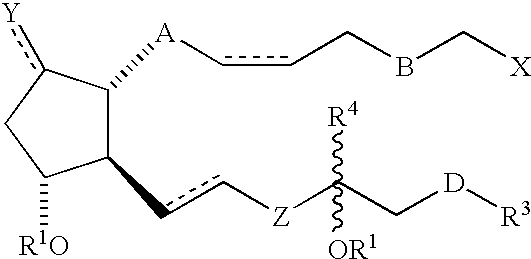3, 7 or 3 and 7 thia or oxa prostanoic acid derivatives as agents for lowering intraocular pressure
a technology of thia or oxa prostanoic acid and derivatives, which is applied in the direction of biocide, elcosanoid active ingredients, drug compositions, etc., can solve the problems of pupil blockage, acute attack, and impeded drainage of aqueous humor
- Summary
- Abstract
- Description
- Claims
- Application Information
AI Technical Summary
Problems solved by technology
Method used
Image
Examples
example 2
(R)-4-(tert-Butyldimethylsilanyloxy)-6-oxabicyclo[3.1.0]hexan-2-one (3)
Hydrogen peroxide (4.5 mL, 46.3 mmol, 30% wt. % solution in water) and 1N NaOH (46 .mu.L, 0.046 mmol) were added to a solution of enone 2 (2.5 g, 11.5 mmol) in MeOH (30 mL) at 0.degree. C. After stirring 1.5 h at 0.degree. C. the mixture was concentrated in vacuo, washed with saturated aqueous NH.sub.4 Cl and extracted with CH.sub.2 Cl.sub.2 (3.times.). The combined organics were washed with brine, dried (Na.sub.2 SO.sub.4), filtered and concentrated in vacuo to afford the above titled compound.
example 3
({3-[(R)-3-(tert-Butyldimethylsilanyloxy)-5-oxocyclopent-1-enylsulfanyl]propylsulfanyl}acetic acid methyl ester (5)
The epoxide 3 prepared above was diluted with CH.sub.2 Cl.sub.2 (30 mL), (3-mercaptopropylsulfanyl) acetic acid methyl ester 4 (1.93 g, 10.7 mmol), prepared according to Chem. Pharm. Bull. 28 (2), 1980, 558-566, was added and the solution was cooled to 0.degree. C. Basic alumina (11.9 g) was added and the reaction mixture was warmed to room temperature. After stirring for 18 h the mixture was filtered through celite and concentrated in vacuo. The residue was purified by flash column chromatography (silica gel, 6:1 hex / EtOAc) to yield 3.6 g (80%) of the above titled compound.
example 4
(3-{(1R,2S,3R)-3-(tert-Butyldimethylsilanyloxy)-2-[(S)-(E)-3-(tert-butyldimethylsilanoxy)oct-1-enyl]-5-oxocyclopentylsulfanyl}propylsulfanyl)acetic acid methyl ester (7)
tert-Butyllithium (1.47 mL of a 1.7M solution in pentane, 2.5 mmol) was added dropwise to a solution of tert-butyl[(S)-1-((E)-2-iodovinyl) hexyloxy]dimethylsilane 6 (462.5 mg, 1.25 mmol) in Et.sub.2 O (6.0 mL) at -78.degree. C. After stirring for 30 min lithium 2-thienylcyanocuprate (6.0 mL of a 0.25M solution in THF, 1.5 mmol) was added and the reaction was stirred an additional 30 min at -78.degree. C. A solution of enone 5 (430 mg, 1.1 mmol) in Et.sub.2 O (1 mL) was added and stirring was continued for an additional 1 h. The reaction mixture was then quickly poured into saturated aqueous NH.sub.4 Cl cooled to 0.degree. C. The mixture was extracted with EtOAc and the organic portion was washed with brine, dried (Na.sub.2 SO.sub.4), filtered and concentrated in vacuo. The residue was quickly purified by flash column...
PUM
| Property | Measurement | Unit |
|---|---|---|
| temperature | aaaaa | aaaaa |
| temperature | aaaaa | aaaaa |
| pH | aaaaa | aaaaa |
Abstract
Description
Claims
Application Information
 Login to View More
Login to View More - R&D
- Intellectual Property
- Life Sciences
- Materials
- Tech Scout
- Unparalleled Data Quality
- Higher Quality Content
- 60% Fewer Hallucinations
Browse by: Latest US Patents, China's latest patents, Technical Efficacy Thesaurus, Application Domain, Technology Topic, Popular Technical Reports.
© 2025 PatSnap. All rights reserved.Legal|Privacy policy|Modern Slavery Act Transparency Statement|Sitemap|About US| Contact US: help@patsnap.com



